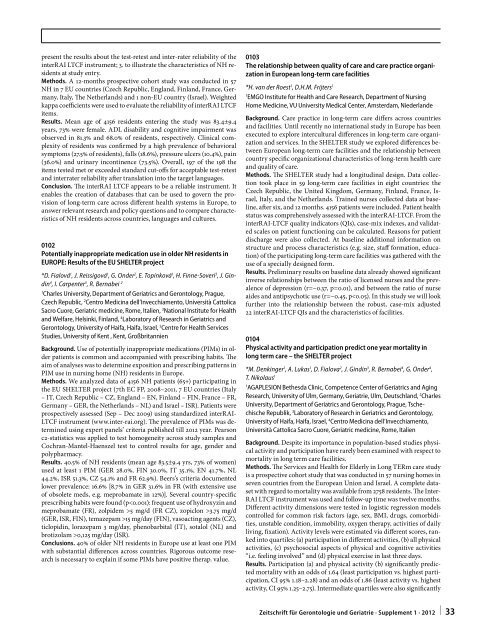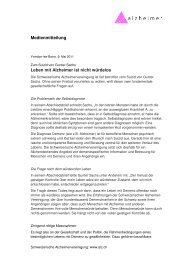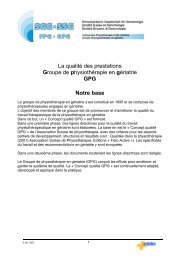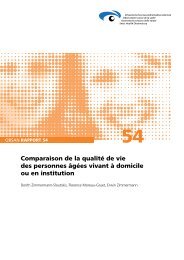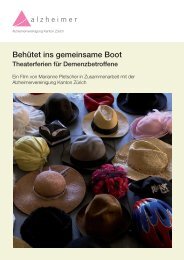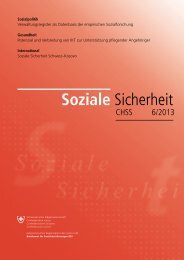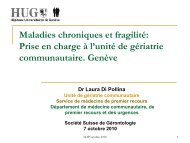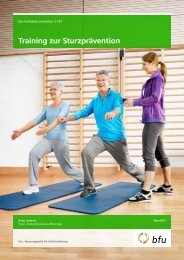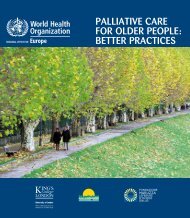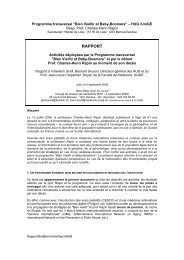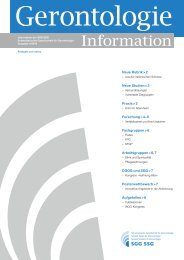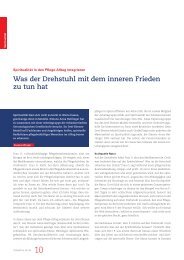Gerontologie+ Geriatrie - SGG-SSG
Gerontologie+ Geriatrie - SGG-SSG
Gerontologie+ Geriatrie - SGG-SSG
Sie wollen auch ein ePaper? Erhöhen Sie die Reichweite Ihrer Titel.
YUMPU macht aus Druck-PDFs automatisch weboptimierte ePaper, die Google liebt.
present the results about the test-retest and inter-rater reliability of the<br />
interRAI LTCF instrument; 3. to illustrate the characteristics of NH residents<br />
at study entry.<br />
Methods. A 12-months prospective cohort study was conducted in 57<br />
NH in 7 EU countries (Czech Republic, England, Finland, France, Germany,<br />
Italy, The Netherlands) and 1 non-EU country (Israel). Weighted<br />
kappa coefficients were used to evaluate the reliability of interRAI LTCF<br />
items.<br />
Results. Mean age of 4156 residents entering the study was 83.4±9.4<br />
years, 73% were female. ADL disability and cognitive impairment was<br />
observed in 81.3% and 68.0% of residents, respectively. Clinical complexity<br />
of residents was confirmed by a high prevalence of behavioral<br />
symptoms (27.5% of residents), falls (18.6%), pressure ulcers (10.4%), pain<br />
(36.0%) and urinary incontinence (73.5%). Overall, 197 of the 198 the<br />
items tested met or exceeded standard cut-offs for acceptable test-retest<br />
and interrater reliability after translation into the target languages.<br />
Conclusion. The interRAI LTCF appears to be a reliable instrument. It<br />
enables the creation of databases that can be used to govern the provision<br />
of long-term care across different health systems in Europe, to<br />
answer relevant research and policy questions and to compare characteristics<br />
of NH residents across countries, languages and cultures.<br />
0102<br />
Potentially inappropriate medication use in older NH residents in<br />
EUROPE: Results of the EU SHELTER project<br />
*D. Fialová 1 , J. Reissigová 1 , G. Onder 2 , E. Topinková 1 , H. Finne-Soveri 3 , J. Gindin<br />
4 , I. Carpenter 5 , R. Bernabei 2<br />
1<br />
Charles University, Department of Geriatrics and Gerontology, Prague,<br />
Czech Republic, 2 Centro Medicina dell’Invecchiamento, Università Cattolica<br />
Sacro Cuore, Geriatric medicine, Rome, Italien, 3 National Institute for Health<br />
and Welfare, Helsinki, Finland, 4 Laboratory of Research in Geriatrics and<br />
Gerontology, University of Haifa, Haifa, Israel, 5 Centre for Health Services<br />
Studies, University of Kent , Kent, Großbritannien<br />
Background. Use of potentially inappropriate medications (PIMs) in older<br />
patients is common and accompanied with prescribing habits. The<br />
aim of analyses was to determine exposition and prescribing patterns in<br />
PIM use in nursing home (NH) residents in Europe.<br />
Methods. We analyzed data of 4156 NH patients (65+) participating in<br />
the EU SHELTER project (7th EC FP, 2008–2011, 7 EU countries (Italy<br />
– IT, Czech Republic – CZ, England – EN, Finland – FIN, France – FR,<br />
Germany – GER, the Netherlands – NL) and Israel – ISR). Patients were<br />
prospectively assessed (Sep – Dec 2009) using standardized interRAI-<br />
LTCF instrument (www.inter-rai.org). The prevalence of PIMs was determined<br />
using expert panels’ criteria published till 2012 year. Pearson<br />
c2-statistics was applied to test homogeneity across study samples and<br />
Cochran-Mantel-Haenszel test to control results for age, gender and<br />
polypharmacy.<br />
Results. 40.5% of NH residents (mean age 83.5±9.4 yrs, 73% of women)<br />
used at least 1 PIM (GER 28.0%, FIN 30.0%, IT 35.1%, EN 41.7%, NL<br />
44.2%, ISR 51.3%, CZ 54.1% and FR 62.9%). Beers’s criteria documented<br />
lower prevalence: 16.6% [8.7% in GER 31.6% in FR (with extensive use<br />
of obsolete meds, e.g. meprobamate in 12%)]. Several country-specific<br />
prescribing habits were found (p5 mg/d (FR CZ), zopiclon >3.75 mg/d<br />
(GER, ISR, FIN), temazepam >15 mg/day (FIN), vasoacting agents (CZ),<br />
ticlopidin, lorazepam 3 mg/day, phenobarbital (IT), sotalol (NL) and<br />
brotizolam >0,125 mg/day (ISR).<br />
Conclusions. 40% of older NH residents in Europe use at least one PIM<br />
with substantial differences across countries. Rigorous outcome research<br />
is necessary to explain if some PIMs have positive therap. value.<br />
0103<br />
The relationship between quality of care and care practice organization<br />
in European long-term care facilities<br />
*H. van der Roest 1 , D.H.M. Frijters 1<br />
1<br />
EMGO Institute for Health and Care Research, Department of Nursing<br />
Home Medicine, VU University Medical Center, Amsterdam, Niederlande<br />
Background. Care practice in long-term care differs across countries<br />
and facilities. Until recently no international study in Europe has been<br />
executed to explore intercultural differences in long-term care organization<br />
and services. In the SHELTER study we explored differences between<br />
European long-term care facilities and the relationship between<br />
country specific organizational characteristics of long-term health care<br />
and quality of care.<br />
Methods. The SHELTER study had a longitudinal design. Data collection<br />
took place in 59 long-term care facilities in eight countries: the<br />
Czech Republic, the United Kingdom, Germany, Finland, France, Israel,<br />
Italy, and the Netherlands. Trained nurses collected data at baseline,<br />
after six, and 12 months. 4156 patients were included. Patient health<br />
status was comprehensively assessed with the interRAI-LTCF. From the<br />
interRAI-LTCF quality indicators (QIs), case-mix indexes, and validated<br />
scales on patient functioning can be calculated. Reasons for patient<br />
discharge were also collected. At baseline additional information on<br />
structure and process characteristics (e.g. size, staff formation, education)<br />
of the participating long-term care facilities was gathered with the<br />
use of a specially designed form.<br />
Results. Preliminary results on baseline data already showed significant<br />
inverse relationships between the ratio of licensed nurses and the prevalence<br />
of depression (r=−0.37, p=0.01), and between the ratio of nurse<br />
aides and antipsychotic use (r=−0.45, p


